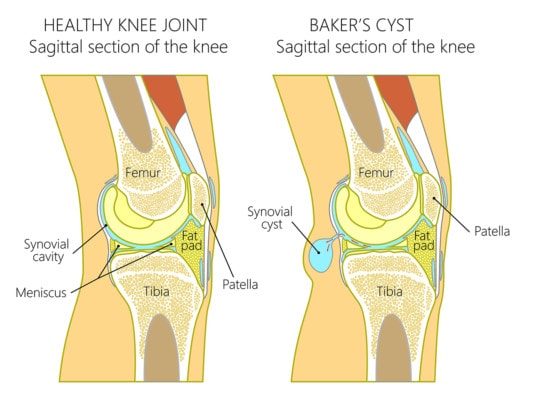Getting Rid of a Baker’s Cyst without Surgery: Exact Placement Matters
Knee baker’s cyst surgery? A Baker’s cyst is a fluid filled area at the back of the knee that can cause pain and reduce range of motion of the knee. In essence, when the knee joint swells, in some patients that swelling shows up as a Baker’s cyst at the back of the knee. Many times, once the blind injection of steroids fails, the cyst is often removed surgically. We’ve demonstrated the ability to get rid of the cyst without surgery by the specific injection of certain substances into the cyst.

Aksanaku/Shutterstock
This brings up our Orthopedics 2.0 philosophy (see our practice’s e-book for more info) that exact placement of next generation biologics is very important. For example, there’s published research showing that extremely exact placement of stem cells into a knee increases the outcome of the injection. In fact, we’ve pioneered several technologies and devices to improve the accuracy of stem cell placement into various joints. A new research study continues to support the concept by finding that specific placement of medication in a knee gets better results than just placing the medication blind into the joint. This new study used ultrasound guidance to place steroid medications directly into a Baker’s cyst. While I wouldn’t recommend anyone consider placing high dose steroids into a knee due to the fact that the medication will likely cause cartilage problems, the study illustrates an important point. The group of patients who had the medicine placed directly into the Baker’s cyst via ultrasound guidance did better than those with blind injection into the joint.
We believe the same holds true to the placement of everything from platelet rich plasma to stem cells, exact placement of any substance into an area of cartilage breakdown, a meniscus tear, or a Baker’s cyst will result in better results than blind injection of the joint without expertise or imaging guidance.

NOTE: This blog post provides general information to help the reader better understand regenerative medicine, musculoskeletal health, and related subjects. All content provided in this blog, website, or any linked materials, including text, graphics, images, patient profiles, outcomes, and information, are not intended and should not be considered or used as a substitute for medical advice, diagnosis, or treatment. Please always consult with a professional and certified healthcare provider to discuss if a treatment is right for you.
